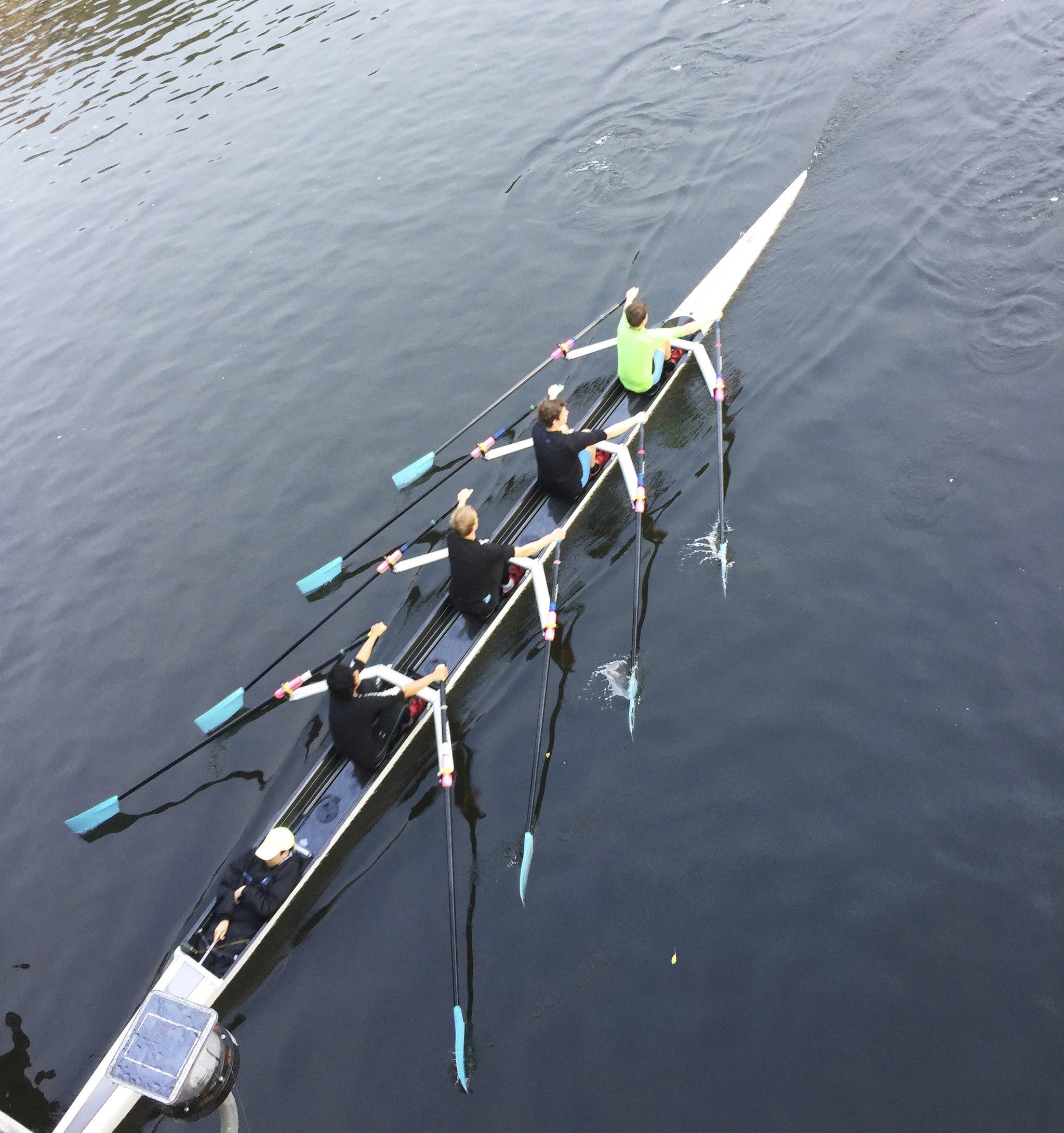Vashon Island Rowing Club’s juniors were divided last weekend with some at a regatta on the East coast and others traveling internationally. The team was also larger than usual with the addition of members from a visiting German rowing team. Despite the distance and logistics, the team brought home a number of medals and placed well in a national event on Sunday.
A women’s youth eight boat and men’s youth coxed quad were invited to the prestigious Head of the Charles Regatta in Boston, Massachusetts, where the 52nd annual race was held on the Charles River — which was buffeted by high winds and rain on Sunday when each of Vashon’s races took place.
Despite the challenging gale conditions on the water, the men’s boat placed 11th in a field of 27 boats on the three-mile course. Most impressively, they placed well despite being a mostly lightweight boat in an open weight race. The men’s boat included David Nguyen, Seth Rosen, Beckett Reid and Cooper Py, with Coxswain Lucca Shattuck.
The women’s eight, coxed by Josie Slade, placed in the middle of the field of 85 boats, in 45th place.
“Great job by our two coxswains, Lucca and Josie, who steered really well in tough conditions on one of the most famous courses in the world,” Vashon’s head coach Richard Parr said.
Junior rowers invited to compete do so in the midst of masters, collegiate and national teams.
“Our launching area was the same one used by this year’s Olympians, so it was great for the Vashon crews to meet and be in really close proximity with the best rowers in the world,” Parr said.
The Head of the Charles this year included more than 11,000 entries from around the world, and spectators numbering in the thousands lined the river to see the race. Clubs whose entries place high enough are invited back the following year to race in the same category, though the balance of spots is determined by lottery. The men’s coxed quad received an automatic invite for 2017 based on their standing this year.
With one-third of the team in Boston, the rest of the VIRC junior rowers competed in Victoria, British Columbia, at the Head of the Gorge and Tail of the Gorge races, sponsored by the University of Victoria. They were joined by rowers and coaches from Germany’s Berliner Ruder-Club Aegir. The club is visiting the island for two weeks with nine student rowers and coxswains.
The German rowers had the dual challenges of speaking and understanding English in high-pressure situations and in some cases, rowing with just one oar (known as sweeping), which is something they don’t train for until they are 15 or 16 years old — at their club, younger rowers first master sculling, which is with two oars. Even with the lack of familiarity with sweeping, they were skillful contributors to many of the medaling boats over the weekend.
“This is a great opportunity to broaden their horizons athletically and culturally,” Hannes Heppner, Berliner Ruder-Club Aegir coach said. “It is great the way that rowing can connect people from around the world.”
VIRC assistant coach Tom Kicinski agreed.
“I’ve been very impressed with how the two clubs have come together as rowers and athletes in general,” he said.
The 3,800-meter Head of the Gorge was held Saturday, and the race is known for having one of the most unusual starts to any regatta in the world. That’s because the Head and Tail races are held on opposite ends of the Gorge Waterway, which is a tidal river dividing the city of Victoria. To reach the start of the Head of the Gorge, rowers must make it upstream through rapids caused by the incoming tide at a narrow bridge without crashing into rocks on the side. A coach familiar with the rapids calls out commands from the bridge to rowers so that they can position themselves in the rapids in such a way that they can make it safely through. It’s difficult enough that some boats try multiple times to make it up and are finally disqualified.
All of the VIRC boats made it up the rapids without incident, and three medaled on Saturday. The women’s eight came in first with a time of 15:21.95. Rowers Olivia White, Ivy Jaguzny, Kate Lande, Tiffany Huestis, Emma Greenlee, Sam Zeigler, Mabel Moses and Maya Gould were coxed by Hayden Rosen.
The junior men’s eight won a bronze medal, as did the junior women four. Each included rowers from the German team, and the women’s four included Berlin coxswain Helene Aign, along with rowers Pippa Slade, Maria Abe, Lucie Hartfiel and Ava Lorentzen. That boat also had the distinction of being rigged as a “fuad” — a combination of a four and a quad, with two seats having two oars and two seats with a single oar. The unusual rigging was due to a lack of enough sculling rigs, but worked just fine on the course.
The Tail of the Gorge held on Sunday lacks all of the starting-line drama of its counterpart, but the same serene scenery, starting at the terminus of the tidal waterway and making its way 3,500 meters across mostly calm waters. Sunday’s sunny weather and light winds made it a great day for racing.
Both silvers for the day were earned by boats that included both Vashon and Berlin rowers. The junior women’s quad and open novice women’s eight came in second in their respective races. The junior women’s eight earned bronze with an all-Vashon crew.
“It’s difficult to gauge our success, as we are rowing against mostly Canadian teams, who we won’t see again during our regular season,” Kicinski said. “It’s great to see us out here being competitive and rowing at a high level.”
VIRC’s next regatta is the Portland Fall Classic this weekend.
— Anne Higuera is the parent of a VIRC junior rower.


